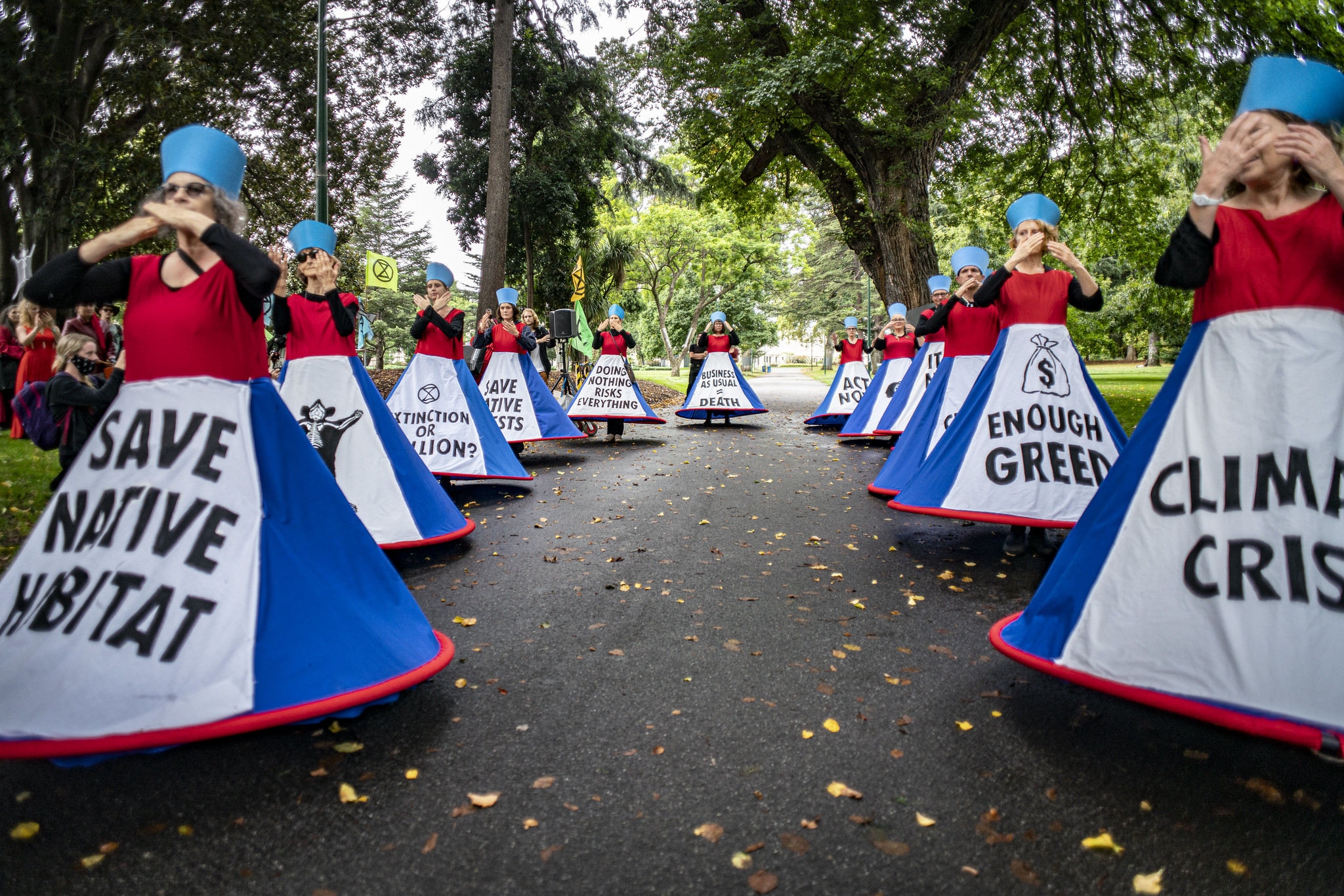All human beings have valid claims against all states that are destroying the planet’s atmospheric commons, writes Jeremy Brecher.

A session at COP26 in Glasgow, Nov. 5. (UNclimatechange, Flickr)
By Jeremy Brecher
Common Dreams
 Since the end of the feudal era the world order has been largely structured by the nation-state system. Individuals have been willing to kill and die for their countries. The pursuit of individual and collective interests has occurred largely within a national framework.
Since the end of the feudal era the world order has been largely structured by the nation-state system. Individuals have been willing to kill and die for their countries. The pursuit of individual and collective interests has occurred largely within a national framework.
Nonetheless, social and political movements have often transgressed national boundaries and expressed solidarities that go beyond them. People frequently join together in social movements that embody the principle and practice of solidarity. And these movements often cut across national boundaries.
A few historical examples:
- The “Age of Democratic Revolutions” between 1760 and 1800 saw people in dozens of countries participate in uprisings and movements to establish popular control of the state. While these movements advocated national independence, there was extensive solidarity and mutual support among them.
- The international abolitionist movement spread throughout Europe and the Americas, abolished slavery in most major countries, and eventually made enslavement a crime worldwide.
-

English cartoon published in the Industrial Workers of the World (IWW) journal Solidarity on June 30, 1917. (Ralph Chaplin, Wikimedia Commons)
The rise of labor and socialist movements in the nineteenth and twentieth centuries embodied a solidarity across national borders. From its inception, the International Workingmen’s Association (First International) sent money, printed leaflets, and organized boycotts in support of workers engaged in fights in countries all over Europe.
- The nuclear disarmament movement of the 1950s, 1960s and 1980s spread all over the world, penetrating the supposedly impenetrable “iron curtain,” establishing its independence from both Cold War “blocs,” and ultimately helping bring about a ban on nuclear testing and an 80 percent reduction in strategic weapons.
- In the 1960s, the movement against the Vietnam War spread around the world, challenged the countries that had allied with the U.S. in its war against Vietnam, and eventually contributed to the crisis in U.S. policy that led to the withdrawal of U.S. troops from Vietnam.
- The Women’s Liberation Movement, which grew out of discussions in the Civil Rights Movement, has come to contest gender inequality in every country and sphere of life around the world.
- The environmental movement spread rapidly in the late 1960s. The underlying ecological concept of the interdependence of all forms of life developed from absurdity to common sense, and environmental legislation became a global norm. The global character of the movement was exhibited by the annual Earth Day, in which tens of millions of people participated in countries around the world.
- The February 2003 protests against the U.S. attack on Iraq drew in 15 million people for demonstrations around the world, described by The New York Times as a reminder that “there may still be two superpowers on the planet: the United States and world public opinion.”

Protesters occupy the roof of the National Congress of Brazil in Brasília, June 17, 2013. (Fábio Rodrigues, Pozzebom/ ABr – Agrncia Brasil, CC BY 3.0 br, Wikimedia Commons)
- The global justice movement coordinated action around the world and brought the attempt to form a “new world order” under the World Trade Organization to a halt in the 1999 Battle of Seattle.
- Occupy Wall Street, which began as a sleep-in of a few hundred people in a New York City park, quickly became a worldwide movement with occupations in scores of countries. Its 2011 Day of Action was joined by rallies in more than 1,000 cities in 82 countries.
- The climate movement has from the outset been global — like the global warming it contests. The student-initiated 2019 Global Climate Strike, for example, brought together 7.6 million participants in 6,000 events in 185 countries.
- When Black Lives Matter protests swept across the U.S. after the police killing of George Floyd in Minneapolis on May 25, 2020, hundreds of thousands of people in London, Sydney, Cape Town, Rio de Janeiro, Stockholm, Tokyo, and many other locations in many countries took to the streets in solidarity.
Each of these examples illustrates the globalization of human solidarity. Why, despite the dominance of the nation-state framework, do movements arise in which solidarity transcends nation-state boundaries?
Common Preservation

Sept. 2, 2005: Local residents in New Orleans stand outside of the Superdome, which was used as a shelter during Hurricane Katrina. (National Archives)
In a world where “self-preservation” is often regarded as “the first law of life,” solidarity is a form of action in which mutual aid serves as the means for realizing individual interests. Solidarity is the practice of pursuing individual ends by realizing mutual and common ends.
The process by which solidarity emerges is what the 17th century Digger Gerrard Winstanley called “common preservation,” in which people shift from strategies based on greed and self-aggrandizement to self-interest through common interests.
Solidarity and common preservation are likely to emerge when people discover they are powerless acting alone but may reach their goals in cooperation with others.
This doesn’t happen automatically, but by actively constructing links among people who have been isolated, divided, and even antagonistic.
Such movements have transcended national borders and established transnational cooperation. But they have not yet transmuted the nations and the nation-state system that prevent global human cooperation to address global problems like climate change, nuclear holocaust and injustice.
Climate Insurgency

Dec 3, 2011: March for Climate Justice in Durban, South Africa. (350.org, Flickr, CC BY-NC-SA 2.0)
The nation-state system has helped cause and perpetuate climate destruction. National sovereignty gives states the authority to determine what can or cannot be emitted into the atmosphere in their territories; it is states that authorize the emission of climate-destroying greenhouse gas emissions.
The sovereignty of nations ensures that common human interests are trumped by the authority of the state — allowing governments to destroy the global atmospheric commons without restraint from any higher authority or their people. The system of sovereign nation-states generates a competition in which each state must encourage the exploitation of nature’s resources or face loss of power and wealth within the competitive world order.
The direct and indirect dependence of states and their officials on dominant economic actors — notably, industries that produce and use fossil fuels — often makes governments subordinate to those with an interest in perpetuating climate destruction.
To overcome these limitations, the climate movement needs to become a global, nonviolent constitutional insurgency.

Sybiil Disobedients led a “dance to extinction” through the streets of Melbourne, Australia. (Matt Hrkac, Flickr, CC BY 2.0)
Insurgencies are social movements, but movements of a special type: they reject current rulers’ claims to legitimate authority. Insurgencies often develop from movements that initially make no such challenge to established authority, but eventually conclude that insurgency is necessary to realize their objectives. To effectively protect the earth’s climate and the future of our species, the climate protection movement may well have to become such an insurgency.
A nonviolent insurgency rejects and resists the authority of the state, but it eschews violence. Instead, it exercises power by mobilizing people for various forms of nonviolent mass action that withdraw acquiescence and cooperation from the powers that be.
A constitutional insurgency declares established laws and policies illegitimate and illegal and sets out to establish constitutionally legitimate law through nonviolent self-help. Destruction of the earth’s climate represents a violation of the most fundamental constitutional principles; as federal judge Ann Aiken straightforwardly ruled, “The right to a climate system capable of sustaining human life is fundamental to a free and ordered society.” If established government won’t protect that right, it is up to the people of the world to do so.
Global nonviolent constitutional insurgency is a vehicle for undermining the illegitimate authority of states. Under the public trust doctrine, all people have rights that states, whether their own or others, can’t violate. All human beings have valid claims against all states that are destroying a stable climate.
Today, we can see the emergence of climate solidarity all around us. We can see the emergence of new solidarities — self-preservation transformed to common preservation. But this solidarity is still blocked by a world order based on the war of all against all. One way to overcome the thrust to mutual destruction could be to transform the global climate movement into a global climate insurgency.
Jeremy Brecher is a historian, author and co-founder of the Labor Network for Sustainability. His book Climate Insurgency: A Strategy for Survival available for free download at his personal website. His other books include: Save the Humans? Common Preservation in Action (2020), Strike! (2020), and, co-edited with Brendan Smith and Jill Cutler, In the Name of Democracy: American War Crimes in Iraq and Beyond (Metropolitan/Holt).
This article is from Common Dreams.
The views expressed are solely those of the author and may or may not reflect those of Consortium News.

from “The World Turned Upside Down” by Leon Rosselson
In 1649
To St. George’s Hill,
A ragged band they called the Diggers
Came to show the people’s will
They defied the landlords
They defied the laws
They were the dispossessed reclaiming what was theirs
We come in peace they said
To dig and sow
We come to work the lands in common
And to make the waste land grow
This earth divided
We will make whole
So it will be
A common treasury for all
The sin of property
We do disdain
No man has any right to buy and sell
The earth for private gain
By theft and murder
They took the land
Now everywhere the walls
Rise up at their command
…
Maybe “funny” maybe not ! I did study the Bible for Years, and about this subject, Climate, that everyone blame on Human activities, and their science, they manage to create “injuries” on Planet Earth ! So, in my studies, it is Written : ” God will destroy those destroying the World “. 2 thousand years ago, and before, what was Pollution ? I know not ! Constructions were done, since Egypt, natural materials, hand made, no machineries using OIL , which is Number One polluter ! Then, came Chemistry, mixing this with that, creating un natural substance, to spray fields with non organic values, and on and on .. Then Nuclear Industries, most Dangerous discovery, what is Next ? 5 G ? Nations have meetings to “talk” about Solutions, but have no WILL to stop their expansion of what they use in every bases daily ! Certainly The People can STAND, and Face the Criminals, as we saw with Greta, how far this Voice can REACH those in Power ? It is like saving One Dolphin from One Shark ! Other “problem” is, governments change from one to another constantly, Each has Priorities, and not always the same from before.. What a MESS !